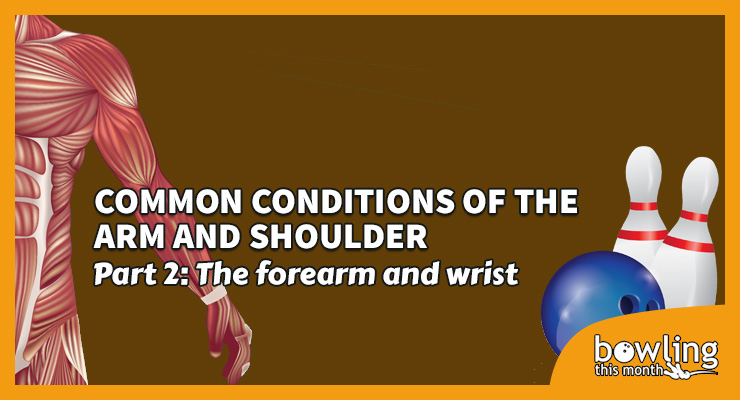Article Contents
- 1. General anatomy
- 2. Structural conditions
- 2.1. Excessive cubitus valgus
- 3. Functional conditions
- 3.1. Dupuytren’s contracture
- 3.2. Lateral epicondylitis (tennis elbow)
- 3.3. Medial epicondylitis (golfer’s elbow)
- 3.4. Cubital tunnel syndrome
- 3.5. Pronator teres syndrome and carpal tunnel syndrome
- 3.6. De Quervain’s tenosynovitis
- 4. Self-care techniques
- 4.1. Rubber band exercises (strengthening)
- 4.2. Dumbbell curls (strengthening)
- 4.3. Towel grip (strengthening)
- 4.4. Cat/cow variation (stretching)
- 5. What’s next?
Note: This article is only available to Bowling This Month subscribers.
In my last article, I discussed some conditions that are often developed by bowlers in their shoulder joint and rotator cuff muscles. This month, I will move down the arm and cover some overuse conditions that can be experienced by bowlers in the forearm and hand. Conditions in this area can be complex due to the intricate anatomy of the small bones, tendons, and ligaments in this part of the body. And, their smaller structures make them very susceptible to injury under high loads and forces.
There is no doubt that bowling places a tremendous amount of repetitive stress on the hand. In the episode of ESPN’s Sport Science series covering the biomechanical loads of bowling, sensors placed on professional bowler Sean Rash’s hand showed that his powerful release put a force of 15 pounds on his ring finger. At one point in the release, one fingertip was supporting 95% of the weight of the bowling ball.
Over time, it is not at all unlikely that a bowler might experience at least one forearm or wrist condition throughout his or her career. I will describe some of the more common ones experienced by bowlers in the sections below. Additionally, I will include a few self-care strategies you can use to prevent the likelihood of occurrence for these conditions. Let’s go ahead and get started.
General anatomy
First, let’s briefly discuss the general anatomy of the forearm and wrist.
The wrist is comprised of eight carpal bones. Most of the movement in the wrist occurs between the first row of carpals and the radius, which runs alongside the ulna. This radiocarpal joint is responsible for flexing and extending the wrist, as well as for lateral deviation of the wrist. Elbow flexion and extension, on the other hand, is conducted by the ulna ...
Already a premium member? Click here to log in.


